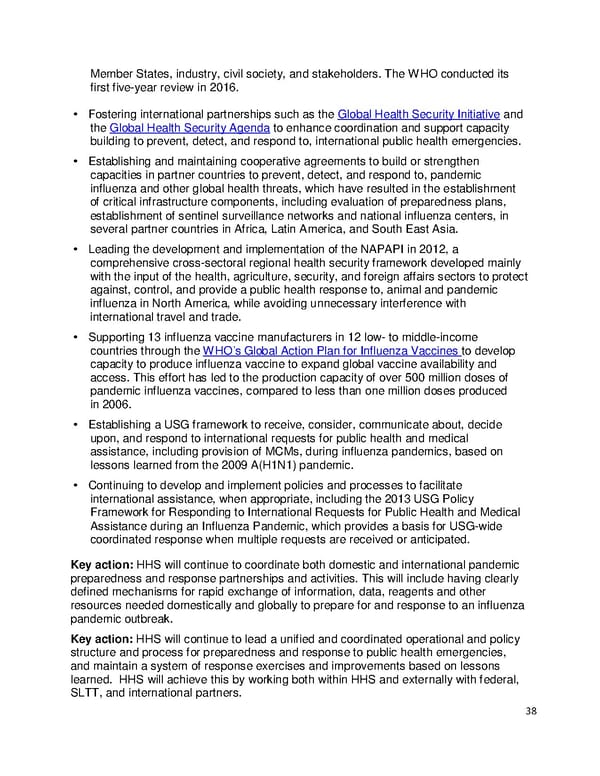Member States, industry, civil society, and stakeholders. The WHO conducted its first five-year review in 2016. • Fostering international partnerships such as the Global Health Security Initiative and the Global Health Security Agenda to enhance coordination and support capacity building to prevent, detect, and respond to, international public health emergencies. • Establishing and maintaining cooperative agreements to build or strengthen capacities in partner countries to prevent, detect, and respond to, pandemic influenza and other global health threats, which have resulted in the establishment of critical infrastructure components, including evaluation of preparedness plans, establishment of sentinel surveillance networks and national influenza centers, in several partner countries in Africa, Latin America, and South East Asia. • Leading the development and implementation of the NAPAPI in 2012, a comprehensive cross-sectoral regional health security framework developed mainly with the input of the health, agriculture, security, and foreign affairs sectors to protect against, control, and provide a public health response to, animal and pandemic influenza in North America, while avoiding unnecessary interference with international travel and trade. • Supporting 13 influenza vaccine manufacturers in 12 low- to middle-income countries through the WHO’s Global Action Plan for Influenza Vaccines to develop capacity to produce influenza vaccine to expand global vaccine availability and access. This effort has led to the production capacity of over 500 million doses of pandemic influenza vaccines, compared to less than one million doses produced in 2006. • Establishing a USG framework to receive, consider, communicate about, decide upon, and respond to international requests for public health and medical assistance, including provision of MCMs, during influenza pandemics, based on lessons learned from the 2009 A(H1N1) pandemic. • Continuing to develop and implement policies and processes to facilitate international assistance, when appropriate, including the 2013 USG Policy Framework for Responding to International Requests for Public Health and Medical Assistance during an Influenza Pandemic, which provides a basis for USG-wide coordinated response when multiple requests are received or anticipated. Key action: HHS will continue to coordinate both domestic and international pandemic preparedness and response partnerships and activities. This will include having clearly defined mechanisms for rapid exchange of information, data, reagents and other resources needed domestically and globally to prepare for and response to an influenza pandemic outbreak. Key action: HHS will continue to lead a unified and coordinated operational and policy structure and process for preparedness and response to public health emergencies, and maintain a system of response exercises and improvements based on lessons learned. HHS will achieve this by working both within HHS and externally with federal, SLTT, and international partners. 38
 Pandemic Influenza Plan Page 37 Page 39
Pandemic Influenza Plan Page 37 Page 39